Grignard reaction
Editor-In-Chief: C. Michael Gibson, M.S., M.D. [1]
Overview
The Grignard reaction, named for the French chemist François Auguste Victor Grignard, is an organometallic chemical reaction in which alkyl- or aryl-magnesium halides (Grignard reagents), which act as nucleophiles, attack electrophilic carbon atoms that are present within polar bonds (e.g., a carbonyl group, see below) to yield a carbon-carbon bond (compare to Wittig reaction), thus altering hybridization about the reaction center.[1] The Grignard reaction is an important tool in the formation of carbon-carbon bonds[2][3] and for the formation of carbon-phosphorus, carbon-tin, carbon-silicon, carbon-boron and other carbon-heteroatom bonds.

The addition to the nucleophile is irreversible due to the high pKa value of the alkyl component (pKa = ~45). Grignard reagents react with electrophilic chemical compounds. It should be noted that such reactions are not ionic; the Grignard reagent exists as an organometallic cluster (in ether). Victor Grignard (University Of Nancy, France) was awarded the 1912 Nobel Prize in Chemistry for the discovery of such reagents. The disadvantage of the Grignard reagents is that they readily react with protic solvents (such as water), or functional groups with acidic protons, such as alcohols and amines. In fact, atmospheric humidity in the lab can dictate one's success when trying to synthesize a Grignard reagent from magnesium turnings and an alkyl halide. To circumvent this issue, the reaction vessel is often flame-dried to evaporate all moisture, then sealed to prevent more from entering.
An example of the Grignard reaction is a key step in the industrial production of Tamoxifen:[4]
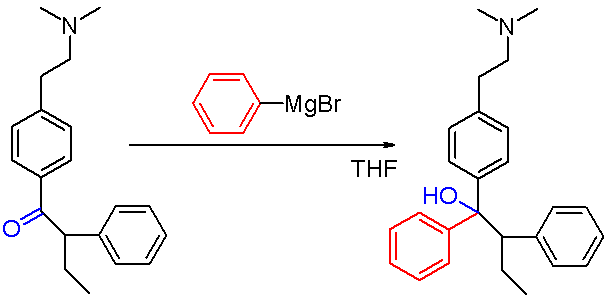
Reaction mechanism
The addition of the Grignard reagent to the carbonyl typically proceeds through a six-membered ring transition state.[5]

However, with hindered Grignard reagents, the reaction may proceed by single-electron transfer.
In a reaction involving Grignard reagents, it is important to ensure that no water is present, which would otherwise cause the reagent to rapidly decompose. Thus, most Grignard reactions occur in solvents such as anhydrous diethyl ether or tetrahydrofuran, because the oxygen of these solvents stabilizes the magnesium reagent. The reagent may also react with oxygen present in the atmosphere, inserting an oxygen atom between the carbon base and the magnesium halide group. Usually, this side-reaction may be limited by the volatile solvent vapors displacing air above the reaction mixture. However, it may be preferable for such reactions to be carried out in nitrogen or argon atmospheres, especially for smaller scales.
Synthesis of Grignard reagents
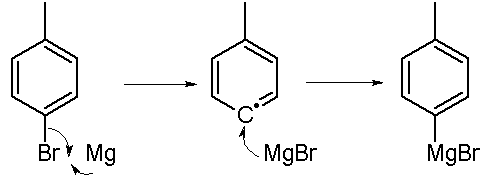
Grignard reagents are formed via the action of an alkyl or aryl halide on magnesium metal.[6] The reaction is conducted by adding the organic halide to a suspension of magnesium in an ether, which provides ligands required to stabilize the organomagnesium compound. Typical solvents are diethyl ether and tetrahydrofuran. Oxygen and protic solvents such as water or alcohols are not compatible with Grignard reagents. The reaction proceeds through single electron transfer.
Grignard reactions often start slowly. As is common for reactions involving solids and solution, initiation follows an induction period during which reactive magnesium becomes exposed to the organic reagents. After this induction period, the reactions can be highly exothermic. Alkyl and aryl bromides and iodides are common substrates. Chlorides are also used, but fluorides are generally unreactive, except with specially activated magnesium, such as Rieke magnesium.
Many Grignard reagents such as phenylmagnesium bromide are available commercially in tetrahydrofuran or diethyl ether solutions.
Via the Schlenk equilibrium, Grignard reagents form varying amounts of diorganomagnesium compounds (R = organic group, X = halide):
- 2 RMgX <math>\overrightarrow{\leftarrow}</math> R2Mg + MgX2
Practical tips
Many methods have been developed to initiate sluggish Grignard reactions. Mechanical methods include crushing of the Mg pieces in situ, rapid stirring, and sonication of the suspension. Iodine, methyl iodide, and 1,2-dibromoethane are commonly employed activating agents. The use of 1,2-dibromoethane is particularly advantageous as its action can be monitored by the observation of bubbles of ethylene. Furthermore, the side-products are innocuous:
- Mg + BrC2H4Br → C2H4 + MgBr2
The amount of Mg consumed by these activating agents is usually insignificant.
The addition of a small amount of mercuric chloride amalgamates the surface of the metal, allowing it to react.
These methods weaken the passivating layer of MgO, thereby exposing highly reactive magnesium to the organic halide.
Variations
Grignard reagents will react with a variety of carbonyl derivatives.[7]
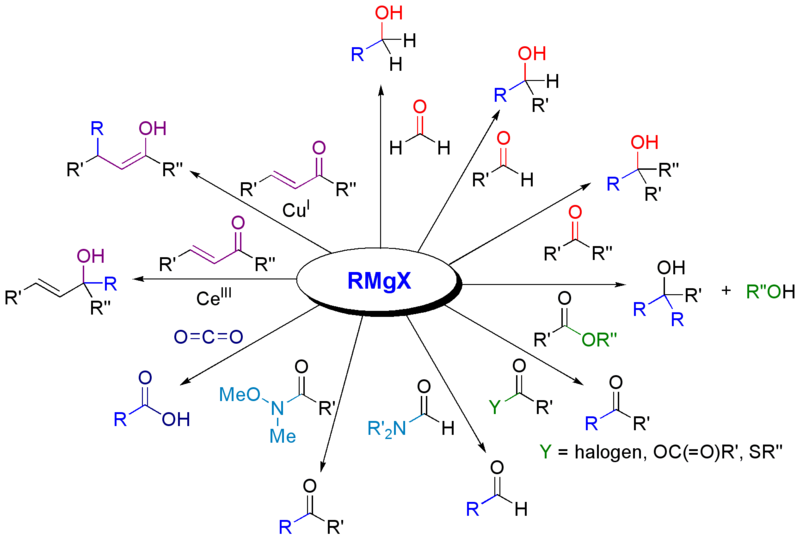
In addition, Grignard reagents will react with other various electrophiles.
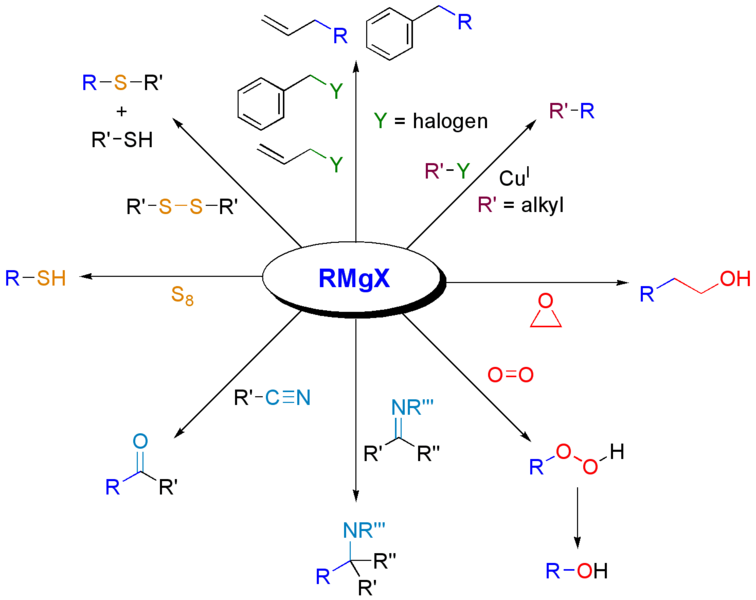
Also the Grignard reagent is very useful for forming carbon-heteroatom bonds.
Coupling reactions
A Grignard reagent can also be involved in coupling reactions. For example, nonylmagnesium bromide reacts with an aryl chloride to a nonyl benzoic acid, in the presence of iron(III) acetylacetonate. Ordinarily, the Grignard reagent will attack the ester over the aryl halide.[8]

For the coupling of aryl halides with aryl Grignards, nickel chloride in THF is also a good catalyst. Additionally, an effective catalyst for the couplings of alkyl halides is dilithium tetrachlorocuprate (Li2CuCl4), prepared by mixing lithium chloride (LiCl) and copper(II) chloride (CuCl2) in THF. The Kumada-Corriu coupling gives access to styrenes.
Oxidation
The oxidation of a Grignard reagent with oxygen takes place through a radical intermediate to a magnesium hydroperoxide. Hydrolysis of this complex yields hydroperoxides and reduction with an additional equivalent of Grignard reagent gives an alcohol.

The synthetic utility of Grignard oxidations can be increased by a reaction of Grignards with oxygen in presence of an alkene to an ethylene extended alcohol.[9] This modification requires aryl or vinyl Grignards. Adding just the Grignard and the alkene does not result in a reaction demonstrating that the presence of oxygen is essential. Only drawback is the requirement of at least two equivalents of Grignard although this can partly be circumvented by the use of a dual Grignard system with a cheap reducing Grignard such as n-butylmagnesium bromide.
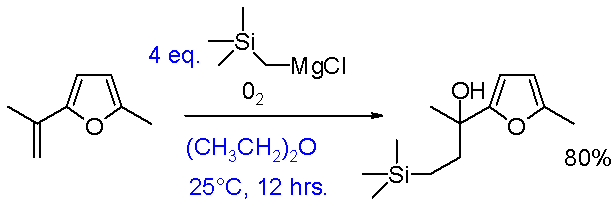
Nucleophilic aliphatic substitution
Grignard reagents are nucleophiles in nucleophilic aliphatic substitutions for instance with alkyl halides in a key step in industrial Naproxen production:

Elimination
In the Boord olefin synthesis, the addition of magnesium to certain β-haloethers results in an elimination reaction to the alkene. This reaction can limit the utility of Grignard reactions.

Grignard degradation
Grignard degradation [10] [11] at one time was a tool in structure elucidation in which a Grignard RMgBr formed from a heteroaryl bromide HetBr reacts with water to Het-H (bromine replaced by a hydrogen atom) and MgBrOH. This hydrolysis method allows the determination of the number of halogen atoms in an organic compound. In modern usage Grignard degradation is used in the chemical analysis of certain triacylglycerols [12].
References
- ↑ Grignard, V. (1900). "Sur quelques nouvelles combinaisons organométaliques du magnésium et leur applicatione à des synthèses d'alcools et d'hydrocabures". Compt. Rend. 130: 1322–1325.
- ↑ Shirley, D. A. Org. React. 1954, 8, 28-58. (Review)
- ↑ Huryn, D. M. Comp. Org. Syn. 1991, 1, 49-75. (Review)
- ↑ Grignard Reagents: New Developments H. G. Richey (Editor) ISBN 0-471-99908-3
- ↑ Maruyama, K.; Katagiri, T. J. Phys. Org. Chem. 1989, 2, 205. (doi:10.1002/poc.610020303)
- ↑ Lai, Y. H. Synthesis 1981, 585-604. (Review)
- ↑ Template:OrgSynth
- ↑ Template:OrgSynth
- ↑ Air-Assisted Addition of Grignard Reagents to Olefins. A Simple Protocol for a Three-Component Coupling Process Yielding Alcohols Youhei Nobe, Kyohei Arayama, and Hirokazu Urabe J. Am. Chem. Soc. 2005, 127(51), 18006 - 18007. (doi:10.1021/ja055732b)
- ↑ Studien in der Thiophenreihe. XXVI. Isomere Bromthiophene und die Konstitution der Thiophendisulfonsäuren (p 136-164) Wilhelm Steinkopf, Hans Jacob, Herbert Penz Justus Liebig's Annalen der Chemie 1934 Volume 512, Issue 1 , Pages 136 - 164 doi:10.1002/jlac.19345120113
- ↑ Studien in der Thiophenreihe. LII. Abkömmlinge des 3-Brom- und 2,3-Dibrom-thiophens Justus Liebig's Annalen der Chemie Volume 543, Issue 1, Date: 1940, Pages: 128-132 Wilhelm Steinkopf doi:10.1002/jlac.19405430110
- ↑ Stereospecific analysis of triacylglycerols via racemic phosphatidylcholines and phospholipase C. Myher,J.J. and Kuksis,A., Can. J. Biochem., 57, 117-124 (1979).
See also
- Barbier reaction
- Bodroux-Chichibabin aldehyde synthesis
- Fujimoto-Belleau reaction
- Organolithium reagents
- Sakurai reaction
Template:Organometallics Template:ChemicalBondsToCarbon
da:Grignardreaktion de:Grignard-Reaktion it:Reattivi di Grignard he:תרכובת גריניאר nl:Grignardreactie fi:Grignardin reagenssi sv:Grignardreaktion